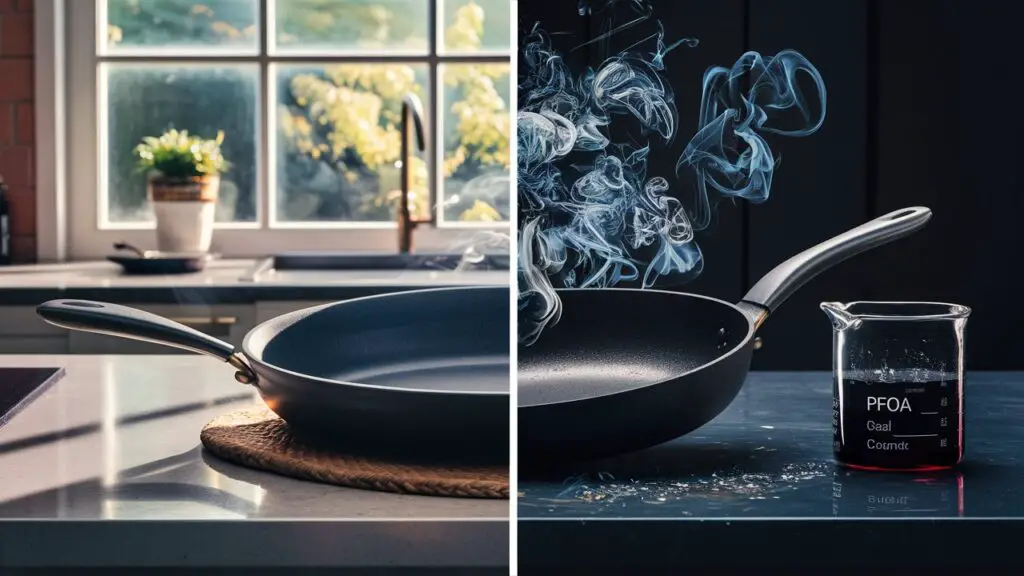As an Amazon Associate BakingBakewareSets.com earns from qualifying purchases.
Is Ceramic Non Stick Coating Safe? A Guide to Healthy and Hassle-Free Cooking
In today’s health-conscious world, many home cooks are rethinking their cookware choices. We understand the concern. Traditional non-stick pans boast incredible convenience, but questions linger about potential health risks.
Are ceramic non-stick coatings a safe alternative? The answer is yes, with some important considerations. Ceramic cookware offers a natural, PFOA-free option that prioritizes both safety and cooking performance.
This comprehensive guide dives deep into the world of ceramic cookware. We’ll explore the benefits and drawbacks of ceramic non-stick coatings, along with essential tips for safe and effective use. We’ll also compare ceramic cookware to other popular options to help you make informed decisions for your kitchen. By the end of this post, you’ll be well-equipped to choose the cookware that best suits your health preferences and cooking style.
The Rise of Non-Toxic Cookware
The growing interest in non-toxic cookware reflects a heightened awareness of potential health risks associated with certain chemicals used in traditional non-stick coatings. Perfluorooctanoic acid (PFOA) has been a particular concern. While PFOA has largely been phased out of cookware manufacturing in recent years (Get Green Be Well [invalid URL removed]), some older pans may still contain it. PFOA exposure has been linked to various health problems, although the exact risks are still being studied.
This is where non-toxic cookware steps in. These pans are specifically designed to avoid PFOA and other potentially harmful chemicals. Ceramic cookware is a leading contender in this category.
Diving into Ceramic Cookware: A Natural Non-Stick Solution

Ceramic cookware features a non-stick coating derived from sand and other naturally occurring minerals. This mineral coating is then bonded to the cookware base at high temperatures. The result is a smooth, slick surface ideal for effortless food release and healthy cooking with minimal oil.
Unlike traditional non-stick coatings, ceramic cookware boasts several key advantages:
- PFOA-free: As mentioned earlier, ceramic coatings are free of PFOA and other potentially harmful chemicals, offering peace of mind for health-conscious cooks.
- Naturally Non-Stick: The mineral-based ceramic coating provides excellent non-stick properties, allowing you to cook with less oil and create healthier meals.
- Easy Cleaning: The smooth, non-stick surface of ceramic cookware makes cleaning up a breeze. Food wipes away easily, saving you time and effort.
However, it’s important to note that ceramic cookware also has some drawbacks to consider:
- Scratch Potential: Ceramic coatings can be susceptible to scratching, especially when using metal utensils. Scratches can compromise the non-stick performance and potentially expose the underlying metal.
- Reduced Longevity: Compared to traditional non-stick options, ceramic coatings may not last as long, especially with heavy use or improper care.
- Lower Heat Tolerance: While ceramic cookware is generally oven-safe up to moderate temperatures, it typically doesn’t handle extreme heat as well as some other materials like cast iron.
Safety Considerations with Ceramic Cookware
To maximize the benefits and safety of your ceramic cookware, follow these essential tips:
- Use silicone or wooden utensils: Metal utensils can scratch the ceramic coating. Opt for silicone or wooden tools to protect the surface and ensure long-lasting performance.
- Hand-washing is recommended: While some ceramic cookware is dishwasher-safe, hand-washing is generally recommended to preserve the coating.
- Avoid abrasive scrubbers: Use gentle sponges or non-abrasive cleaning cloths to avoid damaging the non-stick surface.
- Don’t overheat: Ceramic cookware performs best at moderate temperatures. Avoid preheating on high heat for extended periods.
- Inspect your pans regularly: Regularly check your ceramic cookware for scratches or chipping. If the coating is damaged, it’s best to replace the pan to avoid potential health risks.
Alternatives to Ceramic Cookware: Finding the Right Fit
While ceramic cookware offers a compelling combination of safety and non-stick functionality, it may not be the perfect choice for every kitchen. Here’s a quick look at two other popular non-toxic cookware options:
- Stainless Steel: Stainless steel cookware is known for its durability, versatility, and ability to handle high heat. However, stainless steel is not naturally non-stick and requires oil or cooking spray to prevent sticking.
- Cast Iron: Cast iron skillets and Dutch ovens are incredibly versatile and offer excellent heat retention. Cast iron requires seasoning for optimal performance, but once seasoned, it provides a naturally non-stick surface. However, cast iron cookware is heavy and requires specific maintenance techniques
Frequently Asked Questions About Ceramic Cookware
In addition to the information above, here are some frequently asked questions about ceramic cookware:
- Is ceramic cookware safe for high heat cooking?
Ceramic cookware is generally oven-safe up to moderate temperatures, typically around 450°F to 500°F. It’s not ideal for searing meats at extremely high temperatures.
- Can I use metal utensils with ceramic cookware?
While technically possible, using metal utensils with ceramic cookware is not recommended. Metal utensils can scratch the non-stick coating, compromising its effectiveness and potentially exposing the underlying metal. Opt for silicone or wooden utensils to protect the surface.
- How long does ceramic cookware last?
The lifespan of ceramic cookware varies depending on usage and care. With proper handling, ceramic cookware can last for several years. However, the non-stick performance may gradually decline over time, especially with frequent use or rough scrubbing.
Conclusion: Making Informed Choices for Healthy Cooking
Ultimately, the best cookware for you depends on your individual cooking style and preferences. If you prioritize safety and non-stick functionality for everyday cooking, ceramic cookware is a great option. For those who value extreme heat tolerance and durability, stainless steel or cast iron might be a better fit.
No matter what type of cookware you choose, prioritize safety and proper care. Invest in high-quality cookware from reputable brands and follow the manufacturer’s recommendations for use and cleaning.
By following these tips and the guidance in this blog post, you can make informed decisions about your cookware and enjoy healthy, hassle-free cooking for years to come.


